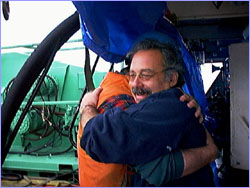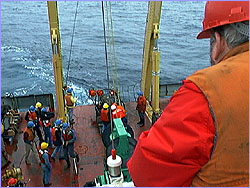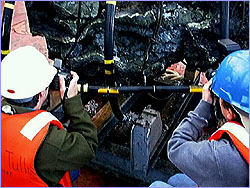
|
 |
 |
by Peter Tyson July 11, 1998 Not long after we pulled up Roane, the second of the sulfide chimneys that this expedition hopes to collect for scientific study and public display, Ingrid Buntschuh, one of the REVEL teachers on board the Thompson, shared her theory about the forest of spires 7,000 feet below. Buntschuh said that the sulfide chimneys were on an expedition to retrieve the John P. Tully for their museum. There was something to what she said. Four days ago, Roane had dug in its heels, holding fast, if you'll recall, until 20,000 pounds of tension held sway on the Fly Away Whatever (see previous dispatch.) Would the next chimney we went after be as tenacious? John Delaney decided that a little cutting with the underwater chain saw might be a good idea after all. So that night, ROPOS sank to the seafloor and attacked Finn. Finn was a true black smoker. Like smoke from a steam engine, the dark fluid billowing from its crown measured over 570°F. Phang had been dead, Roane half-dead. Finn was as alive as Bill Clinton at a fundraiser. Despite the skillful work of the ROPOS pilots, the chain saw took its own sweet time—which we didn't have much of, incidentally. The Tully was slated to leave on Saturday, the 10th, for another mission. Would we be able to snare another chimney after this one? Delaney and Ed Mathez, the expedition co-leaders, wanted, in addition to the trio above, a fourth chimney draped with biology—tubeworms, mussels, and the like. That would complete the range of possibilities in sulfide structures. If all four could be had, the major goal of this expedition would be a success beyond anyone's dreams.
To everyone's surprise, his business was over seconds after the line went taut. Finn broke free as easily as a snowman lifted from the snow. Ever cautious, Olson raised it slowly on the winch, to ensure that such an inferno had time to cool before reaching the surface. Any superheated fluid still remaining inside might flash to steam and blow apart the structure. Which may have happened, as it turned out. Just as the chimney broke the surface, it collapsed, sending a large chunk or two back to the icy depths. But the cables held on to the rest, and Finn was soon aboard. The chimney's collapse revealed a gold mine within. At least it looked like one. The channel through which "black smoke" had so recently risen was encased in a two-inch-thick layer of chalcopyrite, a fool's-gold-like mineral that forms only in the highest-temperature chimneys. A few tens of degrees cooler, and Finn would have had the black wurtzite and sphalerite of its cousin Roane.
But about 1 a.m., an accident occurred, one that threatened to call an immediate, grinding halt to the mission: ROPOS dropped the line basket. It plunged unattended through 7,000 feet of water. Delaney and the ROPOS team decided they would search for the basket until 2:30 a.m.—an hour and a half—and then go to bed, mission unaccomplished. At 2:22 a.m., they spotted the basket—not 60 feet from Gwenen. The rest of the night—I know, for I was there for my usual 4 a.m. watch—ROPOS worked up Gwenen, preparing it for Le Olson's magic. Well, to make a long story short, we got Gwenen, too. It swung over the fantail in late morning, just as a light rain began to fall. Unlike the other three chimneys, this was lush with wildlife. Those drinking-straw worms were there in the thousands, forming a garden of translucent stalks over the five-foot-long structure. Beneath them clung a colorful assortment of invertebrates, which the biologists on board went after with the blind passion of lovers. Ditto the microbiologists, who probed crevices for the microbes that drive the entire ecosystem, like plankton of the abyss. Everyone else, meanwhile, was busy smiling at everyone else. Relief and good cheer were as much in the air as rain, which nobody seemed to notice anyway. Olson beamed his trademark beam. Debbie Kelley's face toggled between concentrated looks at Gwenen and unabashed grins to the world at large. At the back of the fantail, Delaney swooped over to Mathez, with whom he had cooked up this expedition over a period of several years, and gave him a bear hug. Surprising even himself, Mathez responded by kissing his friend of 35 years on the cheek.
Late this afternoon, we watched the Tully steam off toward the eastern horizon. The engineering phase of this expedition was now complete; the science phase would now kick in in earnest. The biologists who have waited so patiently while the engineers did their work will now get to do their own, using ROPOS to explore such pressing questions as: How are the biology and geology integrated? Which drives which? How does the output of gases, the temperature, and the species found change between chimneys, and for what reasons? These and other questions will fill the air aboard the Thompson. Until Saturday, that is. That's when the Thompson will sail into Seattle with the chimneys that proved Ingrid Buntschuh's theory wrong. Peter Tyson is Online Producer of NOVA. The Tug of the Thompson (June 23) The ROPOS Guys (June 25) In the Juan de Fuca Strait (June 27) Special Report: A Visit To Atlantis (June 29) Dive 440 (July 1) Rescue at Sea (July 2) What's Your Position? (July 4) Phang! (July 5) 20,000 Pounds of Tension (July 8) Four for Four (July 11) Thrown Overboard (July 13) Was Grandma a Hyperthermophile? (July 15) Swing of the Yo-Yo (July 18) The Mission | Life in the Abyss | The Last Frontier | Dispatches E-mail | Resources | Table of Contents | Abyss Home Editor's Picks | Previous Sites | Join Us/E-mail | TV/Web Schedule About NOVA | Teachers | Site Map | Shop | Jobs | Search | To print PBS Online | NOVA Online | WGBH © | Updated October 2000 |
 Old friends Ed Mathez and John Delaney celebrate
four chimneys.
Old friends Ed Mathez and John Delaney celebrate
four chimneys.
 The American Museum's Myles Gordon looks down on the
newly secured Gwenen.
The American Museum's Myles Gordon looks down on the
newly secured Gwenen.
 Photographers capture the gold-like chalcopyrite
lining the inside of Finn.
Photographers capture the gold-like chalcopyrite
lining the inside of Finn.
 Half of the sulfide chimney Roane will go to the
American Museum of Natural History.
Half of the sulfide chimney Roane will go to the
American Museum of Natural History.